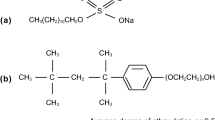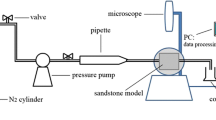In this paper, a new type of Gemini surfactant was synthesized by esterification reaction of phthalic anhydride and fatty alcohol polyoxyethylene ether to improve the pollution problem and achieve the purpose of reservoir restoration in the near-wellbore area. The target product was characterized by infrared spectroscopy and hydrogen nuclear magnetic resonance spectroscopy. The ability of Gemini surfactant to reduce boundary surface tension, wettability, dispersion, viscosity reduction, oil washing and core damage recovery were studied. Gemini surfactant The critical micelle concentration (cmc) and the corresponding γ-cmc of Gemini surfactant are 26 mg/L and 30.26 μN/m, respectively. Gemini surfactant has a good ability to wash oil, which effectively reduce the interfacial tension of oil and water. At the same time, the benzene ring in the molecular structure of Gemini surfactant dissolve the organic matter in the pollution source, and the core permeability could be restored.











Similar content being viewed by others
Reference
Luo Peng. Cause analysis of wellbore blockage in Hechuan Gas Field and its removal measures [J]. Chemical Engineering and Equipment, 2021(12):123-126.
Sonh Gang. Research on Wellbore treatment and Technology of Light oil well in Tahe Oilfield [D]. Southwest Petroleum University, 2010.
Shen Xu. Application of meso-phase and composite perforation technology in plugging removal in the eastern oilfield of South China Sea [J]. Contemporary Chemical Research, 2018(09):70-72.
Wei Long, Yang Jian, Dong Xiaoli, et al. Effects of Nonionic surfactants on the properties of negative/cationic complex surfactants [J]. Petrochemical Industry, 2015, 44(05):602-606.
Diao Pan, Liu Jing, Zhang Yongkui, Liu Jin, Yao Taiping. Washing of oily sludge with anionic/nonionic surfactants [J]. Chemical Industry Progress, 2014, 33(10):2753-2757.
Hu Rui, Li Yingdong, Lu Yijing, et al. Effects of nonionic surfactants on aquatic organisms [J]. Environmental Science and Technology, 2015, 38(S1):15-19.
Xiao Pengfei, Qin Bida, Li Yuwen. Nonionic surfactants enhance the degradation of organochlorine pesticides by white rot bacteria and their crude enzyme solution [J]. Chinese Journal of Applied & Environmental Biology, 2015, 21(01):22-28.
Hu Xuzhi et al. Contrasting impacts of mixed nonionic surfactant micelles on plant growth in the delivery of fungicide and herbicide[J]. Journal of Colloid and Interface Science, 2022, 618: 78-87.
Lu X H. Preparation and properties of ester functionalized amide type Gemini surfactants [D]. Jiangnan University, 2021.
Zhu Ruihua. Preparation and Physicochemical properties of carboxylate type Gemini surfactants [D]. Northeast Petroleum University, 2017.
Zhang J. Synthesis and properties of non-ionic surfactant cashew gluconamide [D]. Zhengzhou University, 2012.
Nan Nan, Chen Gong, Yang Jiping. Synthesis and surface properties of nonylphenol based nonionic Gemini surfactants [J]. Applied Chemical Industry, 2007(04):321-324 (in Chinese)
Da Silva Ramos A C, Haraguchi L, Notrispe F R, et al. Interfacial and colloidal behavior of asphaltenes obtained from Brazilian crude oils[J]. Journal of Petroleum Science and Engineering, 2001, 32(2-4): 201-216.
Ibrahim H H, Idem R O. Interrelationships between asphaltene precipitation inhibitor effectiveness, asphaltenes characteristics, and precipitation behavior during n-heptane (light paraffin hydrocarbon)-induced asphaltene precipitation[J]. Energy & fuels, 2004, 18(4): 1038-1048.
Cheng Yaoshuang. Molecular dynamics simulation of emulsification behavior of surfactant flooding [D]. Shandong University, 2020.
Study on properties of polyoxyethylene etherified nonionic surfactants [J]. Applied Chemical Industry, 201, 50(07):1812-1815 (in Chinese).
Qin Jiaolong. Study on Surface Properties of Fatty alcohol polyoxyethylene ether and its application [D]. Shanghai Normal University, 2014.
Zhang Chaocan, Yan Fei, Li Bing, Zhang Yu-sheng. Study on Surface and Mechanical Properties of polypropylene/Fatty alcohol polyoxyethylene ether Blends [J]. Plastic Science and Technology, 2009, 37(08):25-28.
Shiho Yada et al. Adsorption and aggregation properties of alkoxy-group-modified homogeneous polyoxyethylene alkyl ether nonionic surfactants[J]. Journal of Molecular Liquids, 2019, 284: 586-591.
Kou Hongyan, Tan Fengzhi, Zhou Wei, et al. Synthesis of reactive fatty alcohol polyoxyethylene ether modified surfactants [J]. Journal of Dalian Polytechnic University, 2015, 34(01):37-39. (in Chinese)
Wang Yefei, Bai Yu, Hou Baofeng, et al. Mechanism of surface wettability of oil-wet sandstone modified by cationic/ nonionic composite surfactants [J]. Journal of China University of Petroleum (Natural Science Edition), 2018, 42(02):165-171.
Hou Baofeng. Study on the change of rock surface wettability by surfactant and its enhanced oil recovery [D]. China University of Petroleum (East China), 2016.
Hou Baofeng, Wang Ye-fei, Huang Yong. Mechanistic study of wettability alteration of oil-wet sandstone surface using different surfactants.[J].Applied Surface Science, 2015, 330(14): 56-64.
Fielden M. L., Perrin C., Kremer A., et al. Sugar-based tertiary amino gemini surfactants with a vesicle-to-micelle transition in the endosomal pH range mediate efficient transfection in vitro[J].European Journal of Biochemistry, 2001, 268(5): 1269-1279.
Author information
Authors and Affiliations
Corresponding author
Additional information
Translated from Khimiya i Tekhnologiya Topliv i Masel, No. 2, pp. 152–157, March– April, 2024.
Rights and permissions
Springer Nature or its licensor (e.g. a society or other partner) holds exclusive rights to this article under a publishing agreement with the author(s) or other rightsholder(s); author self-archiving of the accepted manuscript version of this article is solely governed by the terms of such publishing agreement and applicable law.
About this article
Cite this article
Jie, C., Dongyu, Q., Leifeng, M. et al. Synthesis of a New Type of Gemini Surfactants and Study on the Repair Performance of Near-Well Reservoir. Chem Technol Fuels Oils 60, 430–439 (2024). https://doi.org/10.1007/s10553-024-01697-8
Published:
Issue Date:
DOI: https://doi.org/10.1007/s10553-024-01697-8




